Impacts of Diet and Enrichment Interactions on The Performance of Holstein Heifers
KM Kelly1, DH Poole1, GW Smith2, JHC Costa3, AJ Geiger4 and SH Ward1*
1Department of Animal Science, North Carolina State University, USA
2College of Veterinary Medicine, North Carolina State University, USA
3Department of Animal and Food Sciences, University of Kentucky, USA
4Zinpro Corporation, Eden Prairie, Minnesota, USAl
Submission:June 30, 2021; Published:July 29, 2021
*Corresponding author: Stephanie Hill Ward, Assistant Professor, North Carolina State University, 111D Polk Hall, Box 7621, NCSU, Raleigh, NC 27695, USA
How to cite this article: KM Kelly, DH Poole, GW Smith, JHC Costa, AJ Geiger, SH Ward. Impacts of Diet and Enrichment Interactions on The Performance of Holstein Heifers . Dairy and Vet Sci J. 2022; 15(2): 555909. DOI: 10.19080/JDVS.2022.15.555909
Abstract
Environmental enrichment objects such as a grooming brush and calf ball may prevent abnormal behaviors that are common in limit fed dairy heifers. This was tested in a split-plot design using 24 Holstein heifers (161.9 ± 33d of age) housed in six pens (n = 2/enrichment) with either a brush (BR), ball (BA), or no enrichment (NA). In each pen, heifers (n = 2) received either a control diet (CON), fed at 100% of predicted dry matter intake of National Research Council (NRC) recommendations, or a high concentrate limit-fed diet (LIM), fed at 85% of NRC predicted dry matter intake (DMI; NRC 2001), for six weeks. DMI was recorded daily, and body measures were taken weekly. Behaviors such as feed aggression, feed visits, use of enrichment, and play behavior were recorded for 24 hours each week, and lying time was summarized hourly for six weeks. The MIXED procedure of SAS was used to analyze the effects of treatment, date, and all 2-way interactions for all models on behavior, body measures, and lying time. The addition of BA increased play behavior by 8 mins/d (P = 0.01). Heifers, regardless of diet, spent 30 mins more using BR than BA (P = 0.03). Treatment did not affect feed aggression or visits to the feed bunk. When the pen was enriched with BA, LIM heifers spent 72 additional mins/d lying down compared with CON (P = 0.01). The use of enrichment in LIM heifers showed some improvement in lying and standing
Keywords: Dairy heifers; Limit fed; Enrichment; Behavior
Abbreviations: NRC: National Research Council; CON: Control Diet; DMI: Dry Matter Intake
Introduction
Raising replacement dairy heifers should be cost-efficient without compromising production; it accounts for about 20% of the farm’s annual expenses with 60% of that cost related to feed [1]. Since the nutrition programs utilized during heifer development impact the future production of the heifers, the diet provided to dairy heifers influences profitability. Limit-feeding has improved feed efficency in dairy heifers [2,3], reduced feed costs (Loerech, 1996) and improved the digestibility of feed stuffs (Driedger and Loerch, 1999, Clark et al., 2007). Even though limit-feeding may provide producers a cost efficient way to achieve desired average daily gain, previous research has noted behavioral changes in heifers when limit-fed. For example, Hoffman et al. [2] observed increases in vocalization and non-recumbent time and decreased lying time. Increased vocalization is a sign of frustration or hunger and demonstrates decreased welfare of the heifer (Watts and Stookey, 2000) while decreased lying time and increased non-recumbent time contribute to increased lameness [4] and decreased average daily gain (Mogensen et al., 1997, Hänninen et al., 2005). Some studies simply attribute these behavioral changes to signs that the heifers are hungry [4], which could occur when heifers are limit fed if satiety is not reached with a lower forage (i.e. bulk) and greater concentrate (i.e. greater nutrient density) diet.
However, these behaviors can also be attributed to lack of stimuli or increased frustration due to being housed in a bare enviroment [5]. In young dairy calves, environmental enrichment devices such as grooming brushes, ropes and balls have been shown to increase social and locomotion play [6,7] which is considered a sign of positive welfare [8]. To date, there has been no research to determine if behaviors observed by limit-fed heifers are due to bare-environment housing. Therefore, the objective of this study is to determine whether the use of environmental enrichment (e.g., grooming brush or tetherball) can promote positive welfare behavior in limit-fed dairy heifers.
Materials and Methods
Procedures and protocols for heifer experimentation were approved by the North Carolina State University Institutional Animal Care and Use Committee (protocol number 18-117-A).
All animals were housed at the North Carolina Department of Agriculture and Consumer Services Piedmont Research Station in Salisbury, NC. Data collection took place from November to December 2018. Heifers were housed in a three-sided pole barn and were fed individually from Calan bins (American Calan, Northwood, New Hampshire) located in front of the pole barn on a concrete feeding ally which was scraped weekly. The pole barn was an open-bedded pack containing sawdust; new sawdust was added weekly. The barn was divided with panels into 6 equal pens measuring 3.7m x 18.0m, providing each animal with 16.7m2 of space. Three water troughs were placed in the pens such that each trough was shared by two pens (Figure 1).

Twenty-four Holstein heifers (161.9 ± 33d of age, 163.94 kg of initial BW) were randomly assigned to one of the six pens (n=4). Two sets of three pens (replicate 1 and 2) contained either a hanging ball (BA, CalfBall, Future Cow, Longwood, FL), a calf brush (BR, Mini Swinging Brush MSB, Delaval, Kansas City, MO), or no behavior modifier (NA). BR, set 71.1 cm off the ground, and BA, hung 78.7 cm off the ground, were located in the bedded pack portion of the pens.
All heifers were trained to eat individually from Calan bins (Northwood, NH) for one week and were then enrolled in a splitplot design for five weeks. Two heifers in each pen were fed either a limit-fed diet (LIM) or a control diet (CON; Table 1). Heifers fed CON received a diet that met NRC (2001) nutrition requirements for heifers planning to calve at 24 mo of age, targeting an average daily gain of 0.70 kg/d. LIM heifers were fed 85% of NRC DMI requirements for heifers planning to calve at 24 mo of age and targeting an average daily gain of 0.70 kg/d while receiving all required nutrients to support maintenance and growth (i.e less feed, more nutrient dense). All heifers were offered fresh feed between 1100 and 1200 feed intake recorded daily; heifers were given ad libitum access to water. Feed samples from each heifer were collected weekly. Samples were dried in a forced-air oven at 60℃ for 36 hours and ground through a 2 mm screen. Samples were then pooled by week across diet and were analyzed by wet chemistry for DM, NDF and ADF, CP, ME, and the macro-minerals Ca, P, and K (Cumberland Valley Analytical Services, Waynesboro, PA).
Data collection started at the end of the training week (week 0) and continued for 5 weeks (week 1-5). At the beginning of week 0, heifers were equipped with a pedometer (Iceqube, IceRobotics, Scotland, UK), as described by Finney et al. [9], that recorded standing, lying time, and lying bouts every hour for 6 weeks. The pedometer was placed on the left hind leg of each heifer. Data were downloaded from the pedometers weekly by waving a wand reader across the tags.
Behaviors such as interaction with BA or BR, aggression at the feed bunk, and feeder visits were monitored using a security camera system. Two cameras were positioned between the pack and feed alley with one facing into the pack and one facing into the feed alley. Each camera observed two pens at one time. The last two digits of each heifer’s ear tag number were painted across the rump, and new spray paint was applied weekly to help with video identification. Video for all pens was recorded for 24 hours once a week during weeks 1 through 5. Optimal behavior observation time was determined by using a 24-hour time-lapse of weeks 1 and 5 to find the most active periods for each behavior. BA and BR interactions and social and individual play events were recorded for 24-hour periods on weeks 3 and 4, but visits to the feed bunk and aggression at the feed bunk were only recorded from 0600 to 1900 on those weeks. Three trained individuals observed behaviors using Observer XT (Nolbus, Leesburg, VA). This software used the ethogram (Table 2) and front and back pictures of the animals in each pen to record behaviors. Social play behaviors and object use were recorded as timed events while feeding and aggression were recorded as time-independent events.
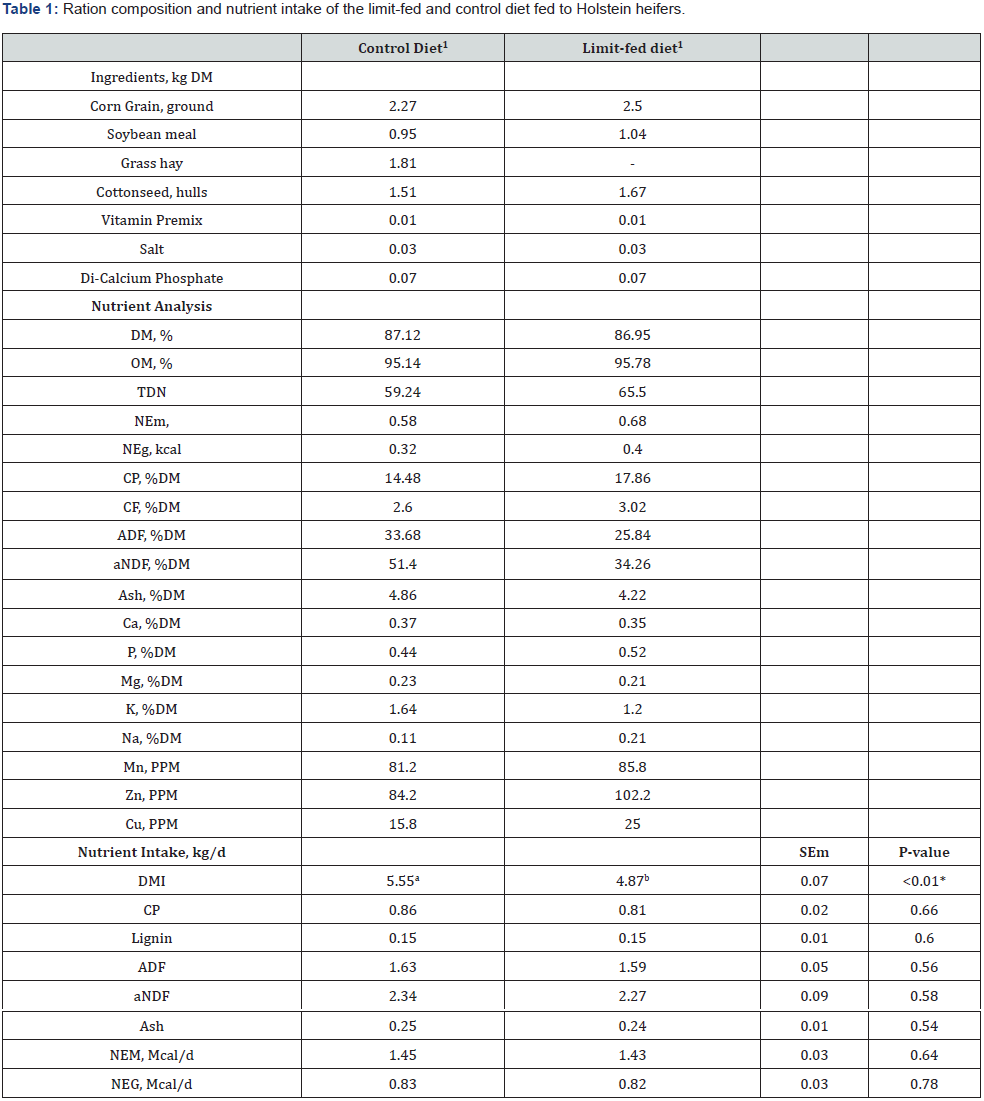
1Control: 100% DM recommendation by NRC (2001) standards. Limit-fed: 85% DM recommendation by NRC (2001) standards.
a,b,c : Within row, means without a common superscript significantly differ (P≤0.05)

A power test conducted using the Proc Power procedure of SAS (Version 9.4, SAS Institute, Inc., Cary, NC) indicated that n = 4 would be necessary to detect a difference in behavior at α = 0.05, β = 0.94. The test was run using a two sample means with acceptable means being a difference of 30 mins of lying time between CON and LIM groups, as determined by Kitt et al. (2014) and [10], respectively.
Data were tested for normality using UNIVARIATE procedure of SAS. Potential outliers were tested using the Grubb’s test for a single outlier in Microsoft Excel (Office 365); no outliers were found. Data were analyzed using a MIXED procedure in SAS 9.4 with the random effect being block (Replicate 1 or 2) and block*enrichment interaction. “Heifer” was considered the experimental unit. The model for all body measures, average daily gain, feed: gain ratio, NEFA, VFA, and most behaviors included enrichment (BA vs. BR vs. NONE), diet (LIM vs. CON), week (date was used for lying time, standing time, and lying bouts), and all 2-way interactions. The model for object interaction included enrichment (BA vs. BR), diet (LIM vs. CON), week, and all 2-way interactions. The linear statistical model is listed below:

Where 𝑖 represents the fixed effect of enrichment, 𝛽𝑗 represents the fixed effect of diet and 𝛼𝛽 (𝑖𝑗) is the fixed interaction between the enrichment and diet. (i) represents the whole-plot error (block error x enrichment error) and (k) represents the split-plot error (enrichment error x diet error x block error). The degrees of freedom for the split-plot design in SAS was df= 3. Results were recorded as least squares means ± SEM. P values were adjusted using Tukey Kramer for multiple comparisons. Statistical significance was reported at P ≤ 0.05. A tendency was reported at a P ≥ 0.05 and ≤ 0.10.
Results and Discussion
CON heifers consumed 0.70 kg/d more DM than LIM (5.56 ± 0.07 v. 4.87 ± 0.07 kg/d, respectively, P < 0.01; Table 1) as intended, but no other differences in nutrient intake were noted. While the LIM diet was 0.08 kcal and 3.4% greater in NEg and CP, restricted intake of LIM resulted in similar nutrient intake and subsequently, no changes in average daily gain (0.48 vs. 0.51 kg/d ± 0.06) or feed: gain ratio (12.5 vs 10.5 ±1.78, P > 0.05; Table 3). In this study, average daily gain was lower than expected, averaging 0.50 kg/d despite a target of 0.70 kg/d. Although feed intake was based on NRC (2001) requirements for 150-200 kg large breed heifers, some studies suggest these values should be greater [3,4]. Therefore, heifers in the current study likely did not have sufficient nutrient intake to achieve the recommended average daily gain. Our study showed exceptionally high, though not significantly different, feed: gain ratios in both feeding groups, likely due to the low average daily gain achieved. Enrichment type did not affect intake or growth performance, as expected.
There was a tendency for CON heifers to have more frequent visits to the feed bunk compared with LIM (Table 4), which was likely related to feed availability. Heifers fed CON had greater volume and density of feed and were less likely to consume it in one bout, resulting in additional visits to the bunk whereas, LIM heifers had less feed and less motivation to return outside of normal feeding times. But LIM heifers demonstrated more aggressive behaviors at the feed bunk (9.2 v. 2.3 ± 1.5 events, respectively, P < 0.01: Table 4). A study conducted by De Paula Vieira et al. [11] showed that restriction of milk intake in preweaned calves led to increased agonistic interactions and other competitive behaviors at the automatic feeding system in grouphoused dairy calves. Therefore, behaviors of our LIM heifers may have been due to hunger despite other work demonstrating no changes in agonistic behaviors between LIM and CON heifers [12]. All heifers continuously decreased visits to the feed bunk over the 6-week period, likely due to the heifers adjusting to the diet (Figure 2).
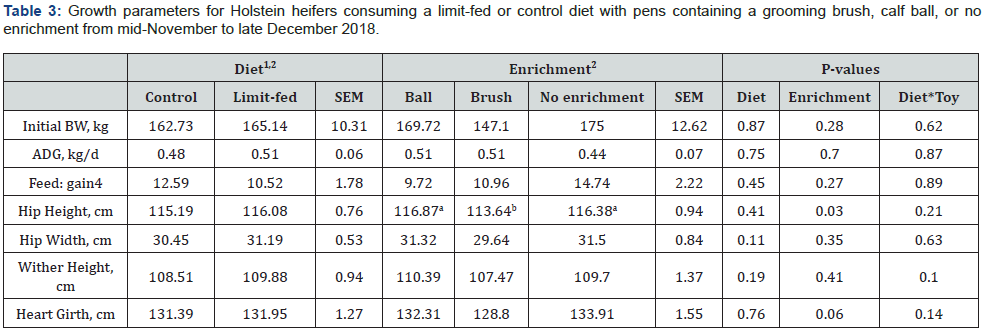
a,b,c: Within row, means without a common superscript significantly differ (P≤0.05)
1Values are reported as least square means and SEM for the experiment.
2Control: 100% DM recommendation by NRC (2001) standards. Limit-fed: 85% DM recommendation by NRC (2001) standards. All nutritional requirements for growth and maintenance were meet.
3Expressed as average DMI/hd/d
4Calculated by dividing DMI/hd/d and average daily gain

a,b,c: Within row, means without a common superscript significantly differ (P≤0.05)
1Values are reported as least square means and SEM for the experiment.
2Control: 100% DM recommendation by NRC (2001) standards. Limit-fed: 85% DM recommendation by NRC (2001) standards. All nutritional requirements for growth and maintenance were meet.
3See ethogram (Table 2) for description of aggressive feed bunk behaviors.
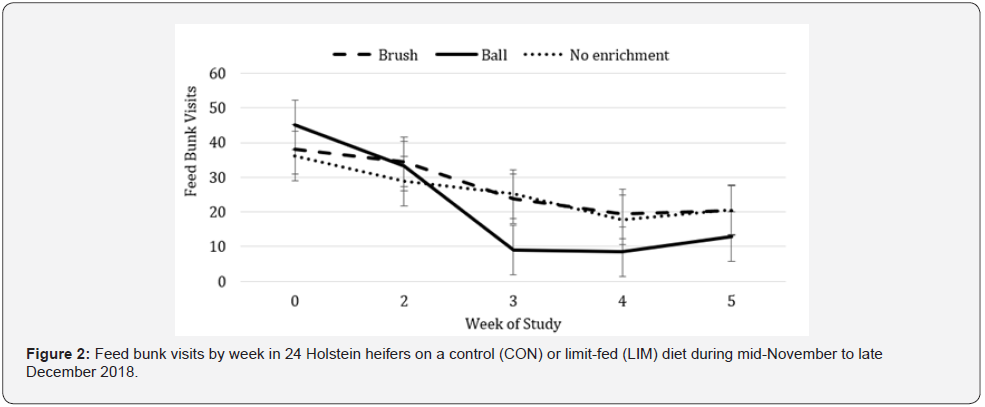
LIM heifers with BA spent 59.1 more min/d lying down compared to those with NA, but the addition of BR for enrichment did not affect lying time (Figure 3, P < 0.05). CON heifers with BA enrichment spent 73 less min/d lying down compared to those with BR but were not different from heifers without enrichment (Figure 3, P < 0.05). LIM heifers with BA or BR spent more time (80.2 min/d and 58.2 min/d, respectively) lying down than CON heifers with BA. Contrary to Hoffman et al. [2] who reported decreased lying time for LIM heifers, our study found that LIM heifers had increased lying time regardless of enrichment type. The addition of straw to the diet had no impact on lying time in Kitts et al.,[4], suggesting enrichment may be a more efficient way of increasing LIM fed heifer lying time.
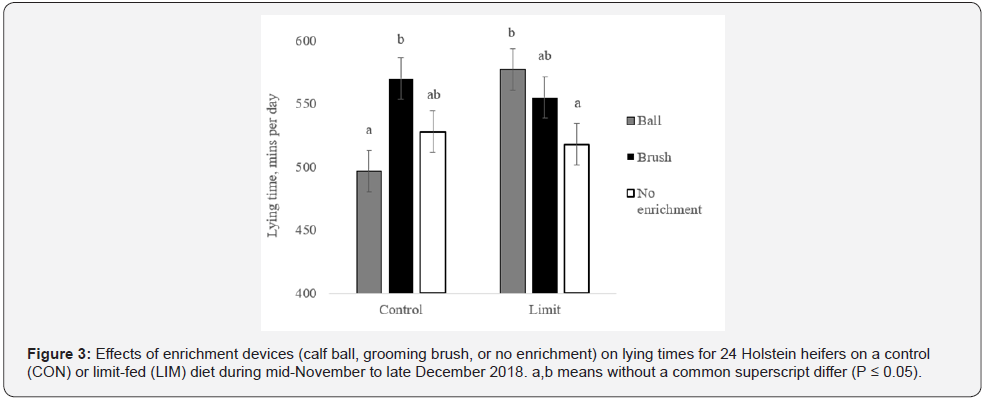
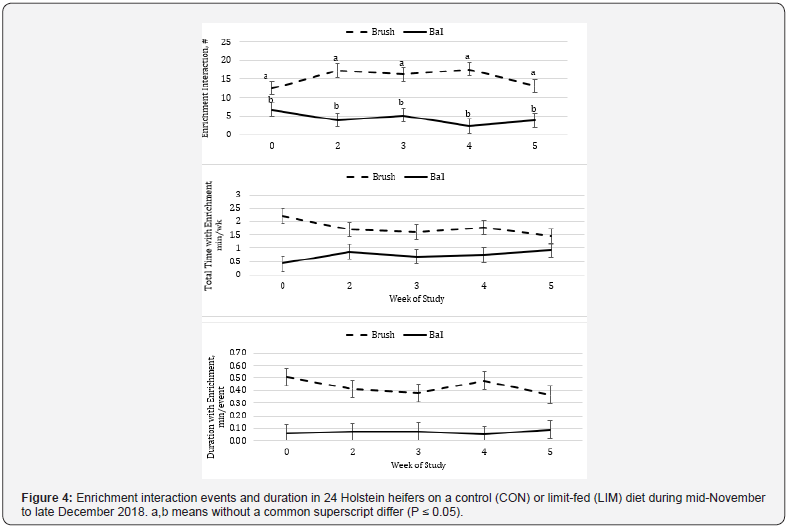
Diet did not affect how many interactions heifers had with each enrichment or social play behaviors. Heifers with BR had 15.3 ± 1.1 interactions/d compared to the 4.3 ± 1.1 interactions/d seen in BA heifers (Figure 4, P<0.01). The average time spent with the enrichment also was increased for BR vs. BA (2.14 ± 0.17 min vs. 1.13 ± 0.17 min, respectively; P = 0.04) as was the total time duration (25.76 ± 1.83 min/d vs. 4.14 ± 1.83 min/d, respectively; P < 0.01; Figure 4), demonstrating that heifers interacted with BR more often and for a longer time than BA. In a similar study, pre-weaned calves enriched with BR and a long rope attached to the wall had 56 more visits/d to the BR compared with the rope, but the calves played with the rope for 20 s/visit longer than BR, leading to no significant difference in total duration (Zobel et al., 2017) [7]. The total duration of BR use, in this study, was similar to that seen in other studies [7,13]. When Ninomiya and Sato (2009) enriched calves with BR, they observed a decrease in the meantime spent using BR on d 51 compared to d 3, perhaps indicating that the novelty of BR was a driver behind interaction. Conversely, we observed that heifers increased the number of visits with BR throughout the trial, similar to findings by Pempek et al. [6]. Individual heifers are known to have preferences for certain objects [7,14]. Variation in visit frequencies and durations could be due to differences in the preferences of individual heifers or desired outcome of the interaction. Inherently, BR provided a grooming opportunity while the play opportunity provided by BA could be replaced by social interaction with pen mates. Others have noted an increase in self-grooming behavior with the addition of grooming brushes to the environment [13].
Heifers with BA increased social play events and total duration of social play during weeks 0 and 5 compared to BR or NA heifers. However, BR heifers showed an increased mean duration of social play across the study (Figure 5). Most studies recording social play show that heifers housed with other animals display increased social play [15]. Since heifers in our study were group-housed for 4 months prior to the start of the experiment, all observed changes in social play were assumed to be due to enrichment objects in the pens, suggesting that the use of enrichment objects in pens promotes positive welfare [16].
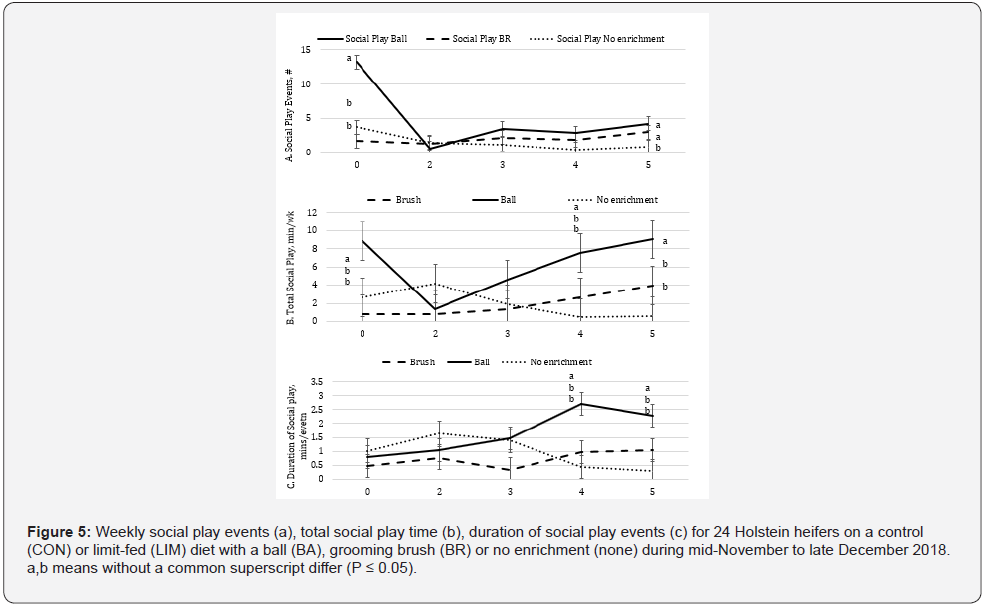
Conclusion
Overall, this study demonstrates that the use of environmental enrichment may improve welfare, with no changes in intake or growth performance, and potentially mitigate some of the negative behaviors typically observed in LIM heifers.
Acknowledgements
This study was partially funded by the North Carolina Dairy Foundation (as part of the NC Ag and Tobacco Foundation). Additionally, in-kind support of grooming brushes was supplied by DeLaval, Inc.
References
- Hawkins A, Burdine KH, Amaral-Phillips DM, Costa JH (2020) Effects of Housing System on Dairy Heifer Replacement Cost from Birth to Calving: Evaluating Costs of Confinement, Dry-Lot, and Pasture-Based Systems and Their Impact on Total Rearing Investment. Frontiers in Veterinary Science 7: 625.
- Hoffman PC, Simson CR, Wattiaux M (2007) Limit Feeding of Gravid Holstein Heifers: Effect on Growth, Manure Nutrient Excretion, and Subsequent Early Lactation Performance. JDairy Sci 90(2): 946-954.
- Lascano GJ, Zanton GI, Suarez-Mena FX, Heinrichs AJ (2009) Effect of limit feeding high- and low-concentrate diets with Saccharomyces cerevisiae on digestibility and on dairy heifer growth and first-lactation performance. J Dairy Sci 92(10): 5100-5110.
- Kitts BL, Duncan IJ H, McBride BW, DeVries TJ (2011) Effect of the provision of a low-nutritive feedstuff on the behavior of dairy heifer’s limit fed a high-concentrate ration. J Dairy Sci 94(2): 940-950.
- Pelley MC, Lirette A, Tennessen T (1995) Observations on the responses of feedlot cattle to attempted environmental enrichment. Can J Anim Sci 75(4): 631-632.
- Pempek JA, Eastridge ML, Proudfoot KL (2017) The effect of a furnished individual hutch pre-weaning on calf behavior, response to novelty, and growth. J Dairy Sci 100(6): 4807-4817.
- Zobel G, Neave HW, Henderson HV, Webster J (2017) Calves Use an Automated Brush and a Hanging Rope When Pair-Housed. Animals (Basel) 7(11): 84.
- Jensen MB, Vestergaard KS, Krohn CC (1998) Play behaviour in dairy calves kept in pens: the effect of social contact and space allowance. Appl Anim Behav Sci 56(2): 97-108.
- Finney G, Gordon A, Scoley G, Morrison SJ (2018) Validating the IceRobotics IceQube tri-axial accelerometer for measuring daily lying duration in dairy calves. Livest Sci 214: 83-87.
- Greter AM, Miller-Cushon EK, McBride BW, Widowski TM, Duffield TF, et al. (2015) Short communication: Limit feeding affects behavior patterns and feeding motivation of dairy heifers. J Dairy Sci 98(2): 1248-1254.
- De Paula Vieira A, Guesdon V, AM de Passillé, MAG von Keyserlingk, DM Weary (2008) Behavioral indicators of hunger in dairy calves. Appl Anim Behav Sci 109(2): 180-189.
- Hoffman P (2007) The potential to limit feed dairy replacement heifers. Proc. Minnesota Nutrition Conference, Pp. 186-192.
- Horvath KC, Miller-Cushon EK (2019) Characterizing grooming behavior patterns and the influence of brush access on the behavior of group-housed dairy calves. J Dairy Sci 102(4): 3421-3430.
- Newberry RC (1995) Environmental enrichment: Increasing the biological relevance of captive environments. Appl Anim Behav Sci 44(2): 229-243.
- Kerr SGC, DGM Wood-Gush (1987) The development of behaviour patterns and temperament in dairy heifers. Behav Processes 15(1): 1-16.
- Ninomiya S (2014) Satisfaction of farm animal behavioral needs in behaviorally restricted systems: Reducing stressors and environmental enrichment. Anim Sci J 85(6): 634-638.






























